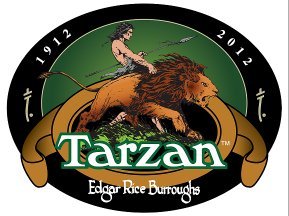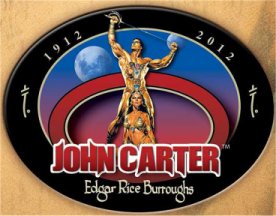.
ERB'S EMBRYONIC JOURNEY:
THE TRIMESTERS OF CASPAK
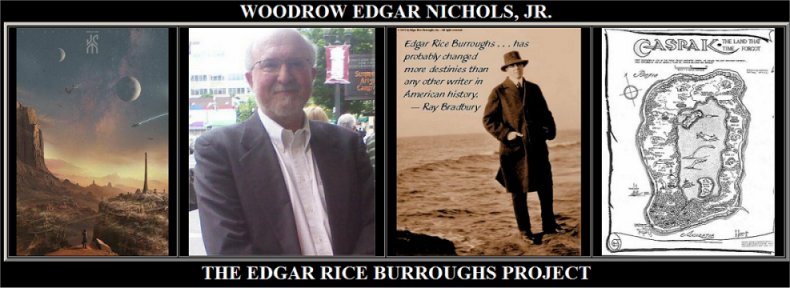
Part Fourteen
by
Woodrow Edgar Nichols, Jr.
(Dedicated to George McWhorter)

THE PEOPLE THAT TIME FORGOT
(Chapter Five)
INTRODUCTION
Now we come to a chapter that is more driven by the overall revelation
of Caspakian Evolution than by danger and action. Thus, even though ERB’s
narrative style always slows down the eye of the speed reader, this is
no time for speed reading. Close attention is required.
Though crazy and straining in credible scientific analysis, ERB’s Caspakian
Evolutionary scheme is quite a lot of fun if you pay attention. It is also
good to remember that the title of this middle book of the trilogy is called
The
People that Time Forgot, and thus is more about the Caspakian people
and semi-people that inhabit the inner crater of Caprona, than about our
first person narrator, Tom Billings. Of course, Billings and his girl,
Ajor, are the main engines of the plot, what little of one there is, as
is always the case in an ERB story.
So, let us return to our rousing adventure. Tom and Ajor, as you recall,
have joined forces with To-mar and So-al, who have both just “evolved,”
or “risen,” nearly simultaneously to the next stage, that of Kro-lu, the
archers. Of course, this is only a temporary arrangement, just enough time
in order for the new Kro-los to prepare their new weapons and apparel before
being accepted into the Kro-lu tribe. This gives ample time for Tom, the
amateur paleontologist, to question these people about their history and
customs.
F. Tom Billings (continued):
“We were sitting before a little fire
inside a safe grotto one night shortly after we had quit the cliff-dwellings
of the Band-lu, when So-al raised a question which it had never occurred
to me to propound to Ajor. She asked her why she had left her own people
and how she had come so far south as the country of the Alus, where I had
found her.
“At first Ajor hesitated to explain; but at last
she consented, and for the first time I heard the complete story of her
origin and experiences. For my benefit she entered into greater detail
of explanation than would have been necessary had I been a native Caspakian.
“‘I am a cos-ata-lo,’ commenced Ajor, and then
she turned toward me. ‘A cos-ata-lo, my Tom, is a woman’ (lo) ‘who did
not come from an egg and thus on up from the beginning.’ (cor-sva-jo).
‘I was a babe at my mother’s breast. Only among the Galus are such, and
then but infrequently. The Wieroo get most of us; but my mother hid me
until I had attained such size that the Wieroo could not readily distinguish
me from one who had come up from the beginning. I knew both my mother and
my father, as only such as I may. My father is high chief among the Galus.
His name is Jor, and both he and my mother came up from the beginning;
but one of them, probably my mother, had completed the seven cycles’ (Approximately
seven hundred years), ‘with the result that their offspring might be cos-ata-lo,
or born as are all the children of your race, Tom, as you tell me is the
fact. I was therefore apart from my fellows in that my children would probably
be as I, of a higher state of evolution, and so I was sought by the men
of my people; but none of them appealed to me. I cared for none. The most
persistent was Du-seen, a hugh warrior of whom my father stood in considerable
fear, since it was quite possible that Du-seen could wrest from him the
chieftainship of the Galus. He has a large following of the newer Galus,
those most recently come up from the Kro-lu, and as this class is usually
much more powerful numerically than the older Galus, and as Du-seen’s ambition
knows no bounds, we have for a long time been expecting him to find some
excuse for a break with Jor the High Chief, my father.
“‘A further complication lay in the fact that
Du-seen wanted me, while I would have none of him, and then came evidence
to my father’s ears that he was in league with the Wieroo; a hunter, returning
late at night, came trembling to my father, saying that he had seen Du-seen
talking with a Wieroo in a lonely spot far from the village, and that plainly
he had heard the words: “If you will help me, I will help you – I will
deliver into your hands all cos-ata-lo among the Galus, now and hereafter;
but for that service you must slay Jor the High Chief and bring terror
and confusion to his followers.’
“‘Now, when my father heard this, he was angry;
but he was also afraid – afraid for me, who am cos-ata-lo. He called me
to him and told me what he had heard, pointing out two ways in which we
might frustrate Du-seen. The first was that I go to Du-seen as his mate,
after which he would be loath to give me into the hands of the Wieroo or
to further abide by the wicked compact he had made – a compact which would
doom his own offspring, who would doubtless be as am I, their mother. The
alternative was flight until Du-seen should have been overcome and punished.
I chose the latter and fled toward the south. Beyond the confines of the
Galu country is little danger from the Wieroo, who seek ordinarily only
Galus of the highest orders. There are two excellent reasons for this:
One is that from the beginning of time jealousy had existed between the
Wieroo and the Galus as to which constituted the highest order and therefore
which could eventually dominate the world. It seems generally conceded
that that race which first reaches a point of evolution which permits them
to produce young of their own species and of both sexes must dominate all
other creatures. The Wieroo first began to produce their own kind – after
which evolution from Galu to Wieroo ceased gradually until now it is unknown;
but the Wieroo produce only males – which is why they steal our female
young, and by stealing cos-ata-lo they increase their own chances of eventually
producing both sexes and at the same time lessen ours. Already the Galus
produce both male and female; but so carefully do the Wieroo watch us that
few of the males ever grow to manhood, while even fewer are the females
that are not stolen away. It is indeed a strange condition, for while our
greatest enemies hate and fear us, they dare not exterminate us, knowing
that they too would become extinct but for us.’
“‘Ah, but could we once get a start, I am sure
that when all were true cosata-lo there would have been evolved at last
the true dominant race before which all the world would be forced to bow.’”
(PTF/5.)
Did you get all of that? It seems that Tom has stumbled onto a scenario
occurring during the long evolution of Caspak that is novel, and wouldn’t
you just know it? – his girl, Ajor, is in the thick of it. From what I
gathered, at the first, like a new branch on the Caspakian evolutionary
tree, the Wieroo were a strange mutation of Galu, and ever since the two
orders have been competing to see which one is the fittest for Caspakian
supremacy: the new branch or the old? Is the new just a freak, dead-end
mutation? Os is the old, like the Neanderthals, bound for the trash heap
of extinction.
And what about that Galu-Wieroo conspiracy going on for the first time
in Caspakian history – even while Ajor tells her story? And what exactly
is a Wieroo? What makes them so frightening?
Tom muses about how Ajor speaks of Caspak as if it’s the only world
that exists and that she must think that Tom comes from a completely different
one, never troubling her pretty head about where that world is or about
how Tom even came to Caspak.
“‘Well,’ she continued, ‘and so I ran
away to hide, intending to pass the cliffs to the south of Galu and find
a retreat in the Kro-lu country. It would be dangerous, but there seemed
no other way.
“‘The third night I took refuge in a large cave
in the cliffs at the edge of my own country; upon the following day I would
cross over into the Kro-lu country, where I felt that I should be reasonably
safe from the Wieroo, though menaced by countless other dangers. However,
to a cos-ata-lo any fate is preferable to that of falling into the clutches
of the frightful Wieroo, from whose land none returns.
“‘I had been sleeping peacefully for several
hours when I was awakened by a slight noise within the cavern. The moon
was shining brightly, illumining the entrance, against which I saw silhouetted
the dread figure of a Wieroo. There was no escape. The cave was shallow,
the entrance narrow. I lay very still, hoping against hope, that the creature
had but paused here to nest and might soon depart without discovering me;
yet all the while I knew that he came seeking me.
“‘I waited, scarce breathing, watching the thing
creep stealthily toward me, its great eyes luminous in the darkness of
the cave’s interior, and at last I knew that those eyes were directed upon
me, for the Wieroo can see in the darkness better than even the lion or
the tiger. But a few feet separated us when I sprang to my feet and dashed
madly toward my menacer in a vain effort to dodge past him and reach the
outside world. It was madness, of course, for even had I succeeded temporarily,
the Wieroo would have but followed and swooped down upon me from above.
As it was, he reached forth and seized me, and though I struggled, he overpowered
me. In the duel his long, white robe was nearly torn from him, and he became
very angry, so that he trembled and beat his wings together in his rage.’”
(PTF/5.)
Ah, here at last come some clues. Wieroos can fly. They wear white robes
and have wings, which is why they can swoop down out of nowhere and what
makes them so damn scary. But are they like the dinosaurs who adapted to
a new environment and now make up the bird kingdom? Was mankind really
meant to fly? And what kind of men are they?
“‘He asked me my name; but I would not
answer him, and that angered him still more. At last he dragged me to the
entrance of the cave, lifted me in his arms, spread his great wings and
leaping into the air, flapped dismally through the night. I saw the moonlit
landscape sliding away beneath me, and then we were out above the sea and
on our way to Oo-oh, the country of the Wieroo.
“‘The dim outlines of Oo-oh were unfolding below
us when there came from above a loud whirring of giant wings. The Wieroo
and I glanced up simultaneously, to see a pair of huge jo-oos’ (flying
reptiles – pterodactyls) ‘swooping down upon us. The Wieroo wheeled and
dropped almost to sea-level, and then raced southward in an effort to oudistance
our pursuers. The great creatures, notwithstanding their enormous weight,
are swift on their wings; but the Wieroo are swifter. Even with my added
weight, the creature that bore me maintained his lead, though he could
not increase it. Faster than the fastest wind we raced through the night,
southward along the coast. Sometimes we rose to great heights, where the
air was chill and the world below but a blur of dim outlines; but always
the jo-oos stuck close behind us.
“‘I knew that we had covered a great distance,
for the rush of the wind by my face attested the speed of our progress,
but I had no idea where we were when at last I realized that the Wieroo
was weakening. One of the jo-oos gained on us and succeeded in heading
us, so that my captor had to turn in toward the coast. Further and further
they forced him to the left; lower and lower he sank. More labored was
his breathing, and weaker the stroke of his once powerful wings. We were
not ten feet above the ground when they overtook us, and at the edge of
a forest. One of them seized the Wieroo by his right wing, and in an effort
to free himself, he loosed his grasp upon me, dropping me to earth. Like
a frightened ecca I leaped to my feet and raced for the sheltering sanctuary
of the forest, where I knew that neither could follow or seize me. Then
I turned and looked back to see two great reptiles tear my abductor asunder
and devour him on the spot.’” (PTF/5.)
Don’t you just love Caspak? Even the Wieroo can be eaten. I must say, Ajor
is a damn good story teller. We could even add another first person narrator
to our list if we wanted to.
But why confuse things any more than they already are? Are we to suspect
that she was being constantly watched by the Wieroo because Du-seen tipped
them off about her? Is that why this one was specifically seeking her?
We are not told for sure, but I believe this idea is on the right track
of analysis. Some times ERB just leaves the reader to parse these things
out for him or herself.
Yes, that Ajor is quite the woman, and she refers to Billings as “my
Tom.” How sweet.
Yes, a true Caspakian to the core and just what Billings needs to survive.
“‘I was saved; yet I felt that I was
lost. How far I was from the country of the Galus I could not guess; nor
did it seem probable that I ever could make my way in safety to my native
land.
“‘Day was breaking; soon the carnivora would
stalk forth for their first kill; I was armed only with my knife. About
me was a strange landscape – the flowers, the trees, the grasses, even,
were different from those of my northern world, and presently there appeared
before me a creature fully as hideous as the Wieroo – a hairy man-thing
that barely walked erect. I shuddered, and then I fled. Through the hideous
dangers that my forebears had endured in the earlier stages of their human
evolution I fled; and always pursuing was the hairy monster that had discovered
me. Later he was joined by others of his kind. They were the speechless
men, the Alus, from whom you rescued me, my Tom. From then on, you know
the story of my adventures, and from the first, I would endure them all
again because they led me to you!’
“It was very nice of her to say that, and I appreciated
it. I felt that she was a mighty nice little girl whose friendship anyone
might be glad to have; but I wished that when she touched me, those peculiar
thrills would not run through me. It was most discomforting, because it
reminded me of love; and I knew that I never could love this half-baked
little barbarian. I was very much interested in her account of the Wieroo,
which up to this time I had considererd a purely mythological creature;
but Ajor shuddered so at even the veriest mention of the name that I was
loath to press the subject upon her, and so the Wieroo still remained a
mystery to me.” (PTF/5.)
Don’t you just love the way ERB makes fun of Tom’s cognitive dissonance
about his true feelings for the girl savage? She gives him erections which
emind him of love. Well, you caninterpret “those peculiar thrills” anyway
you like.
It comes time for To-mar and So-al to confront the Kro-lu chief and
hence they must part ways with the couple, who have had the rare privilege
of coming up from the beginning together.
As a result, Tom gets another insight into Caspakian psychology.
“This was our last day together. In the
afternoon we should separate, Tomar and So-al going directly to the Kro-lu
village, while Ajor and I made a detour to avoid a conflict with the archers.
The former both showed evidence of nervous apprehension as the time approached
for them to make their entry into the village of their new people, and
yet both were very proud and happy. They told us that they would be well
received as additions to a tribe always are welcomed, and the more so as
the distance from the beginning increased, the higher tribes or races being
far weaker numerically than the lower. The southern end of the island fairly
swarms with the Ho-lu, or apes; next above these are the Alus, who are
slightly fewer in number than the Ho-lu; and again there are fewer Bo-lu
than Alus, and fewer Sto-lu than Bo-lu. Thus it goes until the Kro-lu are
fewer in number than any of the others; and here the law reverses, for
the Galu outnumber the Kro-lu.
As Ajor explained it to me, the reason for this
is that as evolution practically ceases with the Galus, there is no less
among them on this score, for even the cosata-lo are still considered Galus
and remain with them. And Galus come up both from the west and the east
coasts. There are, too, fewer carnivorous reptiles at the north end of
the island, and not so many of the great and ferocious members of the cat
family as take their hideous toll of life among the races further south.
“By now I was obtaining some idea of the Caspakian
scheme of evolution, which partly accounted for the lack of young among
the races I had so far seen. Coming up from the beginning, the Caspakian
passes, during a single existence, through the various stages of evolution,
or at least many of them, through which the human race has passed during
countless ages since life first stirred upon a new world; but the question
which continued to puzzle me was: What creates life at the beginning, cor-sva-jo?
“I had noticed that as we traveled northward
from the Alus’ country the land had gradually risen until we were now several
hundred feet above the level of the inland sea. Ajor told me that the Galu
country was still higher and considerably colder, which accounted for the
scarcity of reptiles. The changes in form and kinds of the lower animals
were even more marked than the evolutionary stages of man. The diminutive
ecca, or small horse, became a roughcoated and sturdy little pony in the
Kro-lu country. I saw a greater number of small lions and tigers, though
many of the huge ones still persisted, while the wooly mammoth was more
in evidence, as were several varieties of the Labyrinthadonta. These creatures,
from which God save me, I should have expected to find further south; but
for some unaccountable reason they gain their greatest bulk in the Kro-lu
and Galus countries, though fortunately they are rare. I rather imagine
that they are a very early form of life which is rapidly nearing extinction
in Caspak, though wherever they are found, they constitute a menace to
all forms of life.
“It was mid-afternoon when To-mar and So-al bade
us good-bye. We were not far from Kro-lu village; in fact, we had approached
it much closer than we had intended, and now Ajor and I were to make a
detour toward the sea while our companions went directly in search of the
Kro-lu chief.” (PTF/5.)
What I really find interesting is the way ERB sets up future complications
with what at first sight is just another adventure along the way. The fact
is, as we will soon discover, there are more than one just one conspiracy
going on in Caspak and what occurs among the Kro-lu is just as important
as what occurs among the Galu.
“Ajor and I had gone perhaps a mile or
two and were just about to emerge from a dense wood when I saw that ahead
of us which caused caused me to draw back into concealment, at the same
time pushing Ajor behind me. What I saw was a party of Band-lu warriors
– large, fierce-appearing men. From the direction of their march I saw
that they were returning to their caves, and that if we remained where
we were, they would pass without discovering us.
“Presently Ajor nudged me. ‘They have a prisoner,’
she whispered. ‘He is a Kro-lu.’
“And then I saw him, the first fully developed
Kro-lu I had seen. He was a fine-looking savage, tall and straight, with
a regal carriage. To-mar was a handsome fellow; but this Kro-lu showed
plainly in his every physical attribute a higher plane of evolution. While
To-mar was just entering the Kro-lu sphere, this man, it seemed to me,
must be close indeed to the next stage of his development, which would
see him an envied Galu.
“‘They will kill him?’ I whispered to Ajor.
“‘The dance of death,’ she replied, and I shuddered,
so recently had I escaped the same fate. It seemed cruel that one who must
have passed safely up through all the frightful stages of human evolution
within Caspak, should die at the every foot of his goal. I raised my rifle
to my shoulder and took careful aim at one of the Band-lu. If I hit him,
I would hit two, for another was directly behind the first.
“Ajor touched my arm. ‘What would you do?’ she
asked. ‘They are all our enemies.’
“‘I am going to save him from the dance of death,’
I replied, ‘enemy or no enemy,’ and I squeezed the trigger. At the report,
the two Band-lu lunged foward upon their faces. I handed my rifle to Ajor,
and drawing my pistol, stepped out in full view of the startled party.
The Band-lu did not run away as had some of the lower orders of Caspakians
at the sound of the rifle. Instead, the moment they saw me, they let out
a series of demonic war-cries, and raising their spears above their heads,
charged me.
“The Kro-lu stood silent and statuesque, watching
the proceedings. He made no attempt to escape, though his feet were not
bound and none of the warriors remained to guard him. There were ten of
the Band-lu coming for me. I dropped three of them with my pistol as rapidly
as a man might count by three, and then my rifle spoke close to my left
shoulder, and another of them stumbled and rolled over and over upon the
ground. Plucky little Ajor! She had never fired a shot before in all her
life, though I had taught her to sight and aim and how to squeeze the trigger
instead of pulling it. She had practiced these new accomplishments often,
but little had I thought they would make a marksman of her so quickly.
“With six of their fellows put of of the fight
so easily, the remaining six sought cover behind some low bushes and commenced
a council of war. I wished that they would go away, as I had no ammunition
to waste, and I was fearful that they should institute another charge,
some of them would reach us, for they were already quite close. Suddenly
one of them rose and launched his spear. It was the most marvelous exhibition
of speed I have ever witnessed. It seemed to me that he had scarce gained
an upright position when the weapon was halfway upon its journey, speeding
like an arrow toward Ajor. And then it was, with that little life in danger,
that I made the best shot I have ever made in my life. I took no conscious
aim; it was though my subconscious mind, impelled by a stronger power even
than that of self-preservation, directed my hand. Ajor was in danger! Simultaneously
with the thought my pistol flew to position, a streak of incandescent powder
marked the path of the bullet from its muzzle; and the spear, its point
shattered, was deflected from its path. With a howl of dismay the six Band-lu
rose from their shelter and raced away toward the south.
“I turned toward Ajor. She was very white and
wide-eyed, for the clutching fingers of death had all but seized her; but
a little smile came to her lips and an expression of great pride to her
eyes. ‘My Tom!’ she said, and took my hand in hers. That was all – ‘My
Tom!’ and a pressure of the hand. Her Tom! Something stirred within my
bosom. Was it exaltation or was it consternation? Impossible! I turned
away almost brusquely.
“‘Come!’ I said, and strode off toward the Kro-lu
prisoner.” (PTF/5.)
That’s quite a cultural prejudice Billings carries in heart, wouldn’t you
say? It reminds me of the Joan Jett song that goes, “I hate myself for
loving you.” We will see what is in store for our heroes when they interrogate
the Kro-lu warrior in the next installment. Until then, remember, this
is Caspak! Never leave your weapons behind.
(Continued in Part Fifteen)
|



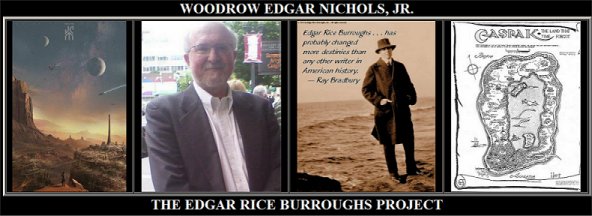
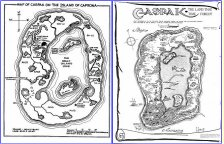

![]()

![]()
